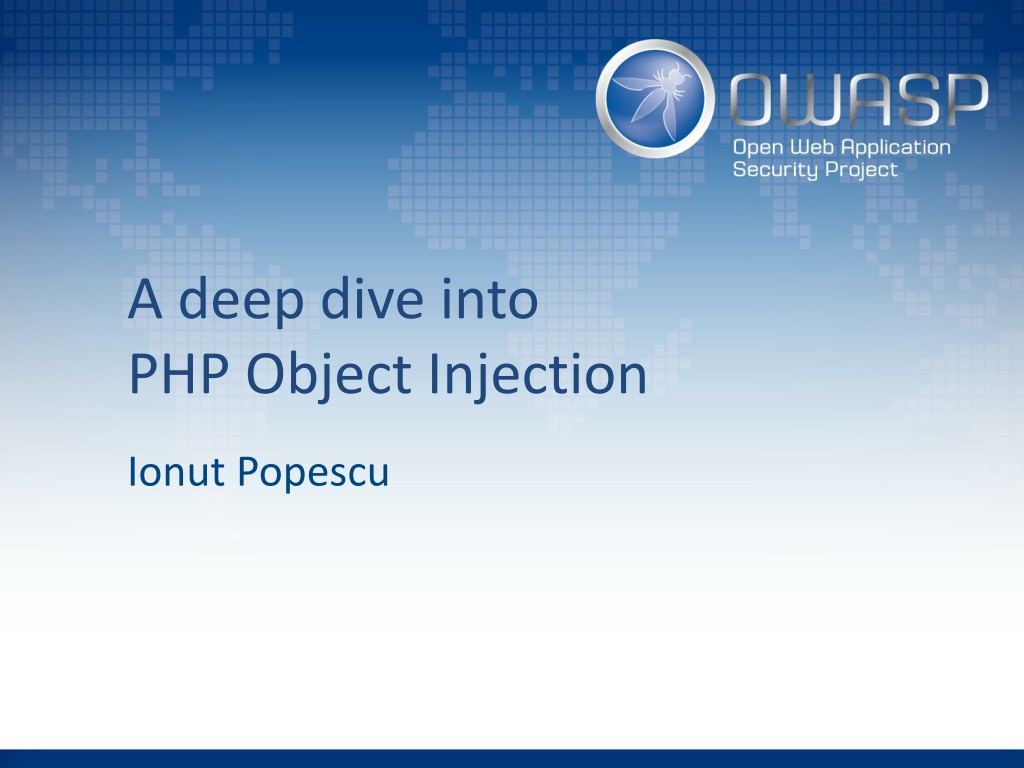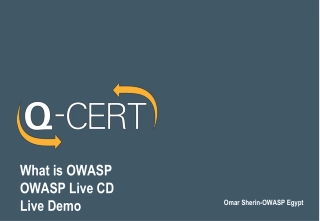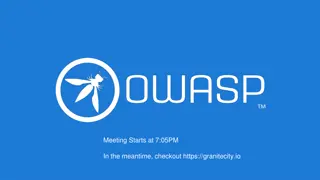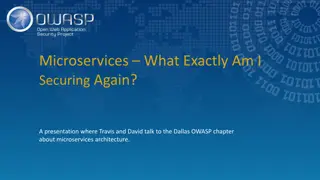Understanding PHP Object Injection Vulnerability
Delve into the potential risks associated with PHP Object Injection, a type of application-level vulnerability that can lead to various malicious attacks such as Code Injection, SQL Injection, and more. Learn how inadequate sanitization of user input can pave the way for attackers to inject arbitrary PHP objects into an application.
Download Presentation

Please find below an Image/Link to download the presentation.
The content on the website is provided AS IS for your information and personal use only. It may not be sold, licensed, or shared on other websites without obtaining consent from the author. Download presentation by click this link. If you encounter any issues during the download, it is possible that the publisher has removed the file from their server.
E N D
Presentation Transcript
A deep dive into PHP Object Injection Ionut Popescu
Contents Part 1: Background information Part 2: Vulnerability exploitation Part 3: Demo
Vulnerability description PHP Object Injection is an application level vulnerability that could allow an attacker to perform different kinds of malicious attacks, such as Code Injection, SQL Injection, Path Traversal and Application Denial of Service, depending on the context. The vulnerability occurs when user-supplied input is not properly sanitized before being passed to the unserialize() PHP function. Since PHP allows object serialization, attackers could pass ad-hoc serialized strings to a vulnerable unserialize() call, resulting in an arbitrary PHP object(s) injection into the application scope. - OWASP
Vulnerable software CubeCart 5.2.0 Drupal 7.34 vBulletin 5.1.0 Tuelap 7.6-4 Moodle 2.5.0 WHMCS 5.2.12 WordPress 3.6.1 Magento 1.9.0.1 Joomla 3.0.3 IP Board 3.3.4 Dotclear 2.6.1 OpenCart 1.5.6.4
PHP Magic Methods __construct() __destruct() __call() __callStatic() __get() __set() __isset() __unset() __sleep() __wakeup() __toString() __invoke() __set_state() __clone() __debugInfo()
Magic methods example Output: __construct This is a string __toString __destruct
Magic methods example #2 Output: Get: Data Set: RHOST = 1.3.3.7 Call: run Invoke: shell
Object serialization serialize Generates a storable representation of a value String s:size:value; Integer i:value; Boolean b:value; (does not store "true" or "false", does store '1' or '0') Null N; Array a:size:{key definition;value definition;(repeated per element)} Object O:strlen(object name):object name:object size:{s:strlen(property name):property name:property definition;(repeated per property)}
Serialization example Output: s:5:"OWASP"; O:8:"stdClass":0:{} b:1; a:3:{i:0;i:1;i:1;i:2;i:2;i:3;} O:8:"stdClass":0:{}
Serialization example #2 User John is 20 years old. O:4:"User":2: { s:3:"age";i:20; s:4:"name";s:4:"John"; }
unserialize magic If the serialized string is an object, unserialize will: 1. Create an object instance (with specified values) 2. Call __wakeup function (if it is present) 3. Call __destruct function (if it is present) at script execution end
Unserialize example __construct __sleep Serialized: O:4:"Test":2:{s:8:"variable";s:4:"BUZZ";s:9:"variable 2";s:5:"OTHER";} __wakeup BUZZ __destruct __destruct
PHP Object Injection Application calls unserialize with user-supplied data There are classes that implement __destruct, __wakeup or other functions Classes are loaded at the unserialize time (autoloading will help)
Exploitation Normal call: script.php?usr_serialized=O:4:"User":2:{s:3:"age";i:20;s:4:"name";s:4:"John";} Exploit: Create a serialized LogFile object that will delete .htaccess on destructor Output: O:7:"LogFile":1:{s:8:"filename";s:9:".htaccess";} __destruct deletes ".htaccess" file. Call: script.php?usr_serialized=O:7:"LogFile":1:{s:8:"filename";s:9:".htaccess";} Result: __destruct deletes ".htaccess" file.
Exploitation #2 Normal call: script.php?usr_serialized=O:4:"User":2:{s:3:"age";i:20;s:4:"name";s:4:"John";} Exploit: Create a serialized FileClass object that will read config.php file on __toString Output: O:9:"FileClass":1:{s:8:"filename";s:10:"config.php";} Call: script.php?usr_serialized=O:9:"FileClass":1:{s:8:"filename";s:10:"config.php";} Result: <?php $private_data = 'MAGIC';?>
Other exploitation vectors Other magic methods: __get, __set, __call Normal functions with the same name. E.g. User::getData() Database::getData()
How to fix? Do not use unserialize on user-supplied data Use json_decode
IP Board Vulnerable code /admin/sources/base/core.php: 4021 - 4053
IP Board - Exploitation /ips_kernel/classDb.php: 1841 - 1883
References [1] Understanding PHP Object Injection http://securitycafe.ro/2015/01/05/understanding-php-object-injection/ [2] Classes and Objects http://php.net/manual/en/language.oop5.php [3] Magic Methods http://php.net/manual/en/language.oop5.magic.php [4] unserialize http://php.net/manual/en/function.unserialize.php [5] Shocking News in PHP Exploitation https://www.owasp.org/images/f/f6/POC2009-ShockingNewsInPHPExploitation.pdf [6] Code Reuse Attacks in PHP: Automated POP Chain Generation http://syssec.rub.de/media/emma/veroeffentlichungen/2014/09/10/POPChainGeneration-CCS14.pdf [7] Invision Power Board <= 3.3.4 - "unserialize()" PHP Code Execution https://www.exploit-db.com/exploits/22398/ [8] WordPress < 3.6.1 PHP Object Injection https://vagosec.org/2013/09/wordpress-php-object-injection/ [9] Remote Code Execution exploit in WordPress 3.5.1 https://vagosec.org/2013/12/wordpress-rce-exploit/
Questions? Thank you, Ionut Popescu












